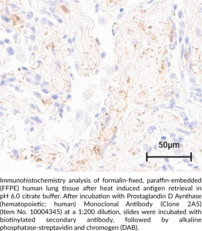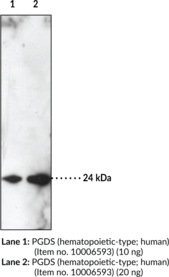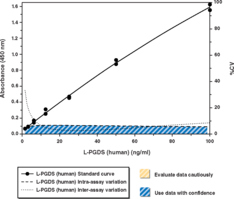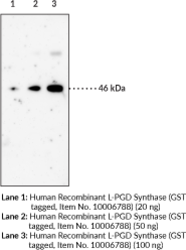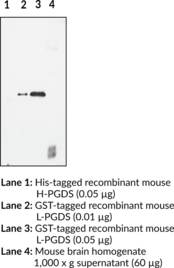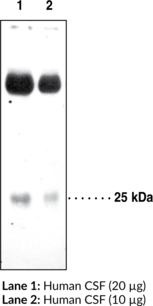Cayman
Showing 36151–36300 of 45550 results
-
Prostaglandin A1 (PGA1) was first isolated as a dehydration product of the PGE1 compounds found in human semen.{411} It has been shown to cause renal vasodilation, increased urine sodium excretion, and lowered arterial pressure in hypertensive patients.{410} It also has growth-inhibitory activity on tumor cells; the IC50 value for the inhibition of human ovarian cancer is 7.5 µM.{1349}
Brand:CaymanSKU:10010 - 10 mgAvailable on backorder
Prostaglandin A1 (PGA1) was first isolated as a dehydration product of the PGE1 compounds found in human semen.{411} It has been shown to cause renal vasodilation, increased urine sodium excretion, and lowered arterial pressure in hypertensive patients.{410} It also has growth-inhibitory activity on tumor cells; the IC50 value for the inhibition of human ovarian cancer is 7.5 µM.{1349}
Brand:CaymanSKU:10010 - 5 mgAvailable on backorder
Prostaglandin A1 (PGA1) was first isolated as a dehydration product of the PGE1 compounds found in human semen.{411} It has been shown to cause renal vasodilation, increased urine sodium excretion, and lowered arterial pressure in hypertensive patients.{410} It also has growth-inhibitory activity on tumor cells; the IC50 value for the inhibition of human ovarian cancer is 7.5 µM.{1349}
Brand:CaymanSKU:10010 - 50 mgAvailable on backorder
Prostaglandin A1 (PGA1) ethyl ester is a prodrug form of PGA1 with enhanced lipid solubility. Prostaglandins of the A-series are natural products of gorgonian soft coral. PGA1 has been shown to cause renal vasodilation, increased urine sodium excretion, and lowered arterial pressure in hypertensive patients.{410} There are no published reports on the biological activity of PGA1 ethyl ester at this time.
Brand:CaymanSKU:10020 - 1 mgAvailable on backorder
Prostaglandin A1 (PGA1) ethyl ester is a prodrug form of PGA1 with enhanced lipid solubility. Prostaglandins of the A-series are natural products of gorgonian soft coral. PGA1 has been shown to cause renal vasodilation, increased urine sodium excretion, and lowered arterial pressure in hypertensive patients.{410} There are no published reports on the biological activity of PGA1 ethyl ester at this time.
Brand:CaymanSKU:10020 - 10 mgAvailable on backorder
Prostaglandin A1 (PGA1) ethyl ester is a prodrug form of PGA1 with enhanced lipid solubility. Prostaglandins of the A-series are natural products of gorgonian soft coral. PGA1 has been shown to cause renal vasodilation, increased urine sodium excretion, and lowered arterial pressure in hypertensive patients.{410} There are no published reports on the biological activity of PGA1 ethyl ester at this time.
Brand:CaymanSKU:10020 - 5 mgAvailable on backorder
Prostaglandin A1 (PGA1) has been shown to cause renal vasodilation, increase urine sodium excretion, and lowers arterial pressure in hypertensive patients.{410} It also has displayed growth-inhibitory activity on tumor cells; the IC50 value for the inhibition of human ovarian cancer is 7.5 µM.{1349,1184} PG A1 methyl ester is a lipophilic analog of PGA1 which may be more amenable for certain formulations or applications.
Brand:CaymanSKU:9000184 - 1 mgAvailable on backorder
Prostaglandin A1 (PGA1) has been shown to cause renal vasodilation, increase urine sodium excretion, and lowers arterial pressure in hypertensive patients.{410} It also has displayed growth-inhibitory activity on tumor cells; the IC50 value for the inhibition of human ovarian cancer is 7.5 µM.{1349,1184} PG A1 methyl ester is a lipophilic analog of PGA1 which may be more amenable for certain formulations or applications.
Brand:CaymanSKU:9000184 - 10 mgAvailable on backorder
Prostaglandin A1 (PGA1) has been shown to cause renal vasodilation, increase urine sodium excretion, and lowers arterial pressure in hypertensive patients.{410} It also has displayed growth-inhibitory activity on tumor cells; the IC50 value for the inhibition of human ovarian cancer is 7.5 µM.{1349,1184} PG A1 methyl ester is a lipophilic analog of PGA1 which may be more amenable for certain formulations or applications.
Brand:CaymanSKU:9000184 - 5 mgAvailable on backorder
PGA2 is a naturally occurring prostaglandin in gorgonian corals where it may function in self defense. It is generally not present in mammals. PGA2 has low biological potency in most bioassays, but it does show some antiviral/antitumor activity.{335} At a 25 µM concentration, PGA2 blocks the cell cycle progression of NIH 3T3 cells at the G1 and G2/M phase.{2678} It has also been shown to act as a vasodilator with natriuretic properties.{1814}
Brand:CaymanSKU:10210 - 1 mgAvailable on backorder
PGA2 is a naturally occurring prostaglandin in gorgonian corals where it may function in self defense. It is generally not present in mammals. PGA2 has low biological potency in most bioassays, but it does show some antiviral/antitumor activity.{335} At a 25 µM concentration, PGA2 blocks the cell cycle progression of NIH 3T3 cells at the G1 and G2/M phase.{2678} It has also been shown to act as a vasodilator with natriuretic properties.{1814}
Brand:CaymanSKU:10210 - 10 mgAvailable on backorder
PGA2 is a naturally occurring prostaglandin in gorgonian corals where it may function in self defense. It is generally not present in mammals. PGA2 has low biological potency in most bioassays, but it does show some antiviral/antitumor activity.{335} At a 25 µM concentration, PGA2 blocks the cell cycle progression of NIH 3T3 cells at the G1 and G2/M phase.{2678} It has also been shown to act as a vasodilator with natriuretic properties.{1814}
Brand:CaymanSKU:10210 - 5 mgAvailable on backorder
Prostaglandin A2 (PGA2) is a naturally occurring PG in gorgonian corals where it may function in self defense. At a 25 µM concentration, PGA2 blocks the cell cycle progression of NIH 3T3 cells at G1 and G2/M by preventing activation of cyclin-dependent kinases.{2678} At similar concentrations, it stabilizes transcripts for the tumor suppressor SMAR1, downregulating cyclin D1 expression.{18712} PGA2 also induces apoptosis in HL-60 cells.{18713} Prostaglandin A2 methyl ester is a lipophilic analog of PGA2 which may be more amenable for certain formulations or applications. Its biological properties have not been evaluated.
Brand:CaymanSKU:9000185 - 1 mgAvailable on backorder
Prostaglandin A2 (PGA2) is a naturally occurring PG in gorgonian corals where it may function in self defense. At a 25 µM concentration, PGA2 blocks the cell cycle progression of NIH 3T3 cells at G1 and G2/M by preventing activation of cyclin-dependent kinases.{2678} At similar concentrations, it stabilizes transcripts for the tumor suppressor SMAR1, downregulating cyclin D1 expression.{18712} PGA2 also induces apoptosis in HL-60 cells.{18713} Prostaglandin A2 methyl ester is a lipophilic analog of PGA2 which may be more amenable for certain formulations or applications. Its biological properties have not been evaluated.
Brand:CaymanSKU:9000185 - 10 mgAvailable on backorder
Prostaglandin A2 (PGA2) is a naturally occurring PG in gorgonian corals where it may function in self defense. At a 25 µM concentration, PGA2 blocks the cell cycle progression of NIH 3T3 cells at G1 and G2/M by preventing activation of cyclin-dependent kinases.{2678} At similar concentrations, it stabilizes transcripts for the tumor suppressor SMAR1, downregulating cyclin D1 expression.{18712} PGA2 also induces apoptosis in HL-60 cells.{18713} Prostaglandin A2 methyl ester is a lipophilic analog of PGA2 which may be more amenable for certain formulations or applications. Its biological properties have not been evaluated.
Brand:CaymanSKU:9000185 - 5 mgAvailable on backorder
Prostaglandin A2-d4 (PGA2-d4) contains four deuterium atoms at the 3, 3′, 4, and 4′ positions. It is intended for use as an internal standard for the quantification of PGA2 by GC- or LC- mass spectrometry. PGA2 is a naturally occurring prostaglandin in gorgonian corals where it may function in self defense. It is generally not present in mammals. It has low biological potency in most bioassays, but does show some antiviral/antitumor activity.{335} At a 25 µM concentration, PGA2 blocks the cell cycle progression of NIH 3T3 cells at the G1 and G2/M phase.{2678} It has also been shown to act as a vasodilator with natriuretic properties.{1814}
Brand:CaymanSKU:310210 - 1 mgAvailable on backorder
Prostaglandin A2-d4 (PGA2-d4) contains four deuterium atoms at the 3, 3′, 4, and 4′ positions. It is intended for use as an internal standard for the quantification of PGA2 by GC- or LC- mass spectrometry. PGA2 is a naturally occurring prostaglandin in gorgonian corals where it may function in self defense. It is generally not present in mammals. It has low biological potency in most bioassays, but does show some antiviral/antitumor activity.{335} At a 25 µM concentration, PGA2 blocks the cell cycle progression of NIH 3T3 cells at the G1 and G2/M phase.{2678} It has also been shown to act as a vasodilator with natriuretic properties.{1814}
Brand:CaymanSKU:310210 - 100 µgAvailable on backorder
Prostaglandin A2-d4 (PGA2-d4) contains four deuterium atoms at the 3, 3′, 4, and 4′ positions. It is intended for use as an internal standard for the quantification of PGA2 by GC- or LC- mass spectrometry. PGA2 is a naturally occurring prostaglandin in gorgonian corals where it may function in self defense. It is generally not present in mammals. It has low biological potency in most bioassays, but does show some antiviral/antitumor activity.{335} At a 25 µM concentration, PGA2 blocks the cell cycle progression of NIH 3T3 cells at the G1 and G2/M phase.{2678} It has also been shown to act as a vasodilator with natriuretic properties.{1814}
Brand:CaymanSKU:310210 - 50 µgAvailable on backorder
Prostaglandin A2-d4 (PGA2-d4) contains four deuterium atoms at the 3, 3′, 4, and 4′ positions. It is intended for use as an internal standard for the quantification of PGA2 by GC- or LC- mass spectrometry. PGA2 is a naturally occurring prostaglandin in gorgonian corals where it may function in self defense. It is generally not present in mammals. It has low biological potency in most bioassays, but does show some antiviral/antitumor activity.{335} At a 25 µM concentration, PGA2 blocks the cell cycle progression of NIH 3T3 cells at the G1 and G2/M phase.{2678} It has also been shown to act as a vasodilator with natriuretic properties.{1814}
Brand:CaymanSKU:310210 - 500 µgAvailable on backorder
Cyclooxygenase metabolism of EPA to produce Prostaglandin E3 (PGE3) has been reported in biosynthetic preparations of ovine seminal vesicles{963} and in the ocular tissues of primates.{1144} Prostaglandin A3 (PGA3) is an expected non-enzymatic dehydration product of this PGE3. PGA3 exhibits good affinity for the canine EP2 and EP4 receptors with IC50 values of 120 nM and 20 nM, respectively, in a radioligand binding assay.{11147,11148} PGA3 has weak affinity for human PPARγ, with a Ki value of 188 µM.{11138}
Brand:CaymanSKU:10310 - 100 µgAvailable on backorder
Cyclooxygenase metabolism of EPA to produce Prostaglandin E3 (PGE3) has been reported in biosynthetic preparations of ovine seminal vesicles{963} and in the ocular tissues of primates.{1144} Prostaglandin A3 (PGA3) is an expected non-enzymatic dehydration product of this PGE3. PGA3 exhibits good affinity for the canine EP2 and EP4 receptors with IC50 values of 120 nM and 20 nM, respectively, in a radioligand binding assay.{11147,11148} PGA3 has weak affinity for human PPARγ, with a Ki value of 188 µM.{11138}
Brand:CaymanSKU:10310 - 25 µgAvailable on backorder
Cyclooxygenase metabolism of EPA to produce Prostaglandin E3 (PGE3) has been reported in biosynthetic preparations of ovine seminal vesicles{963} and in the ocular tissues of primates.{1144} Prostaglandin A3 (PGA3) is an expected non-enzymatic dehydration product of this PGE3. PGA3 exhibits good affinity for the canine EP2 and EP4 receptors with IC50 values of 120 nM and 20 nM, respectively, in a radioligand binding assay.{11147,11148} PGA3 has weak affinity for human PPARγ, with a Ki value of 188 µM.{11138}
Brand:CaymanSKU:10310 - 50 µgAvailable on backorder
Prostaglandin B1 (PGB1) is a non-enzymatic dehydration product of PGE1 resulting from treatment with strong base. Oligomers of PGB1 are known to exhibit antioxidant and ionophoric activity.{833,834,1160}
Brand:CaymanSKU:11110 - 1 mgAvailable on backorder
Prostaglandin B1 (PGB1) is a non-enzymatic dehydration product of PGE1 resulting from treatment with strong base. Oligomers of PGB1 are known to exhibit antioxidant and ionophoric activity.{833,834,1160}
Brand:CaymanSKU:11110 - 10 mgAvailable on backorder
Prostaglandin B1 (PGB1) is a non-enzymatic dehydration product of PGE1 resulting from treatment with strong base. Oligomers of PGB1 are known to exhibit antioxidant and ionophoric activity.{833,834,1160}
Brand:CaymanSKU:11110 - 5 mgAvailable on backorder
Prostaglandin B1 (PGB1) is a non-enzymatic dehydration product of PGE1 resulting from treatment with strong base. Oligomers of PGB1 are known to exhibit antioxidant and ionophoric activity.{833,834,1160}
Brand:CaymanSKU:11110 - 50 mgAvailable on backorder
Prostaglandin B2 (PGB2) is a non-enzymatic dehydration product resulting from the treatment of PGE2 or PGA2 with strong base. It has weak agonist activity on TP receptors and can increase pulmonary blood pressure in the rabbit at relatively high doses (5 µg/kg).{1301}
Brand:CaymanSKU:11210 - 1 mgAvailable on backorder
Prostaglandin B2 (PGB2) is a non-enzymatic dehydration product resulting from the treatment of PGE2 or PGA2 with strong base. It has weak agonist activity on TP receptors and can increase pulmonary blood pressure in the rabbit at relatively high doses (5 µg/kg).{1301}
Brand:CaymanSKU:11210 - 10 mgAvailable on backorder
Prostaglandin B2 (PGB2) is a non-enzymatic dehydration product resulting from the treatment of PGE2 or PGA2 with strong base. It has weak agonist activity on TP receptors and can increase pulmonary blood pressure in the rabbit at relatively high doses (5 µg/kg).{1301}
Brand:CaymanSKU:11210 - 25 mgAvailable on backorder
Prostaglandin B2 (PGB2) is a non-enzymatic dehydration product resulting from the treatment of PGE2 or PGA2 with strong base. It has weak agonist activity on TP receptors and can increase pulmonary blood pressure in the rabbit at relatively high doses (5 µg/kg).{1301}
Brand:CaymanSKU:11210 - 5 mgAvailable on backorder
Prostaglandin B2 (PGB2) is a non-enzymatic dehydration product resulting from the treatment of PGE2 (Item No. 14010) or PGA2 (Item Nos. 10210 | 10007199) with strong base. It has weak agonist activity on TP receptors and can increase pulmonary blood pressure in the rabbit at relatively high doses (5 µg/kg). PGB2 MaxSpec® standard is a quantitative grade standard of PGB2 (Item No. 11210) that has been prepared specifically for mass spectrometry or any application where quantitative reproducibility is required. The solution has been prepared gravimetrically and is supplied in a deactivated glass ampule sealed under argon. The concentration was verified by comparison to an independently prepared calibration standard. This PGB2 MaxSpec® standard is guaranteed to meet identity, purity, stability, and concentration specifications and is provided with a batch-specific certificate of analysis. Ongoing stability testing is performed to ensure the concentration remains accurate throughout the shelf life of the product. Note: The amount of solution added to the vial is in excess of the listed amount. Therefore, it is necessary to accurately measure volumes for preparation of calibration standards. Follow recommended storage and handling conditions to maintain product quality.
Brand:CaymanSKU:10007201 - 100 µgAvailable on backorder
Prostaglandin B2 (PGB2-d4) contains four deuterium atoms at the 3, 3′, 4, and 4′ positions. It is intended for use as an internal standard for the quantification of PGB2 by GC- or LC-mass spectrometry. PGB2 is a non-enzymatic dehydration product resulting from the treatment of PGE2 or PGA2 with strong base. It has weak agonist activity on TP receptors and can increase pulmonary blood pressure in the rabbit at relatively high doses (5 mg/kg).{1301}
Brand:CaymanSKU:311210 - 1 mgAvailable on backorder
Prostaglandin B2 (PGB2-d4) contains four deuterium atoms at the 3, 3′, 4, and 4′ positions. It is intended for use as an internal standard for the quantification of PGB2 by GC- or LC-mass spectrometry. PGB2 is a non-enzymatic dehydration product resulting from the treatment of PGE2 or PGA2 with strong base. It has weak agonist activity on TP receptors and can increase pulmonary blood pressure in the rabbit at relatively high doses (5 mg/kg).{1301}
Brand:CaymanSKU:311210 - 100 µgAvailable on backorder
Prostaglandin B2 (PGB2-d4) contains four deuterium atoms at the 3, 3′, 4, and 4′ positions. It is intended for use as an internal standard for the quantification of PGB2 by GC- or LC-mass spectrometry. PGB2 is a non-enzymatic dehydration product resulting from the treatment of PGE2 or PGA2 with strong base. It has weak agonist activity on TP receptors and can increase pulmonary blood pressure in the rabbit at relatively high doses (5 mg/kg).{1301}
Brand:CaymanSKU:311210 - 50 µgAvailable on backorder
Prostaglandin B2 (PGB2-d4) contains four deuterium atoms at the 3, 3′, 4, and 4′ positions. It is intended for use as an internal standard for the quantification of PGB2 by GC- or LC-mass spectrometry. PGB2 is a non-enzymatic dehydration product resulting from the treatment of PGE2 or PGA2 with strong base. It has weak agonist activity on TP receptors and can increase pulmonary blood pressure in the rabbit at relatively high doses (5 mg/kg).{1301}
Brand:CaymanSKU:311210 - 500 µgAvailable on backorder
Prostaglandin B3 (PGB3) is a non-enzymatic dehydration product resulting from the treatment of Prostaglandin E3 (PGE3) with strong base. In a structure-activity binding study to determine the affinity of various prostaglandins to human PPARγ, PGB3 exhibited a Ki value greater than 1 mM.{11138} In contrast, PGB1 and PGB2 showed significantly higher affinity for PPARγ, with Ki values of 26 and 77 µM, respectively, the same assay.
Brand:CaymanSKU:11990 - 100 µgAvailable on backorder
Prostaglandin B3 (PGB3) is a non-enzymatic dehydration product resulting from the treatment of Prostaglandin E3 (PGE3) with strong base. In a structure-activity binding study to determine the affinity of various prostaglandins to human PPARγ, PGB3 exhibited a Ki value greater than 1 mM.{11138} In contrast, PGB1 and PGB2 showed significantly higher affinity for PPARγ, with Ki values of 26 and 77 µM, respectively, the same assay.
Brand:CaymanSKU:11990 - 25 µgAvailable on backorder
Prostaglandin B3 (PGB3) is a non-enzymatic dehydration product resulting from the treatment of Prostaglandin E3 (PGE3) with strong base. In a structure-activity binding study to determine the affinity of various prostaglandins to human PPARγ, PGB3 exhibited a Ki value greater than 1 mM.{11138} In contrast, PGB1 and PGB2 showed significantly higher affinity for PPARγ, with Ki values of 26 and 77 µM, respectively, the same assay.
Brand:CaymanSKU:11990 - 50 µgAvailable on backorder
PGBx is a mixture of oligomers of PGB1 with a molecular weight of 1,000-1,500. It has antioxidant and free radical trapping activity that was first studied in isolated mitochondria.{477} PGBx has anti-inflammatory and cytoprotective activity which may be attributed to inhibition of the 14 kDa sPLA2.{414,1188} At a dose of 1 mg/kg, PGBx significantly reduces the incidence of ulcers in rats.{414}
Brand:CaymanSKU:11510 - 1 mgAvailable on backorder
PGBx is a mixture of oligomers of PGB1 with a molecular weight of 1,000-1,500. It has antioxidant and free radical trapping activity that was first studied in isolated mitochondria.{477} PGBx has anti-inflammatory and cytoprotective activity which may be attributed to inhibition of the 14 kDa sPLA2.{414,1188} At a dose of 1 mg/kg, PGBx significantly reduces the incidence of ulcers in rats.{414}
Brand:CaymanSKU:11510 - 10 mgAvailable on backorder
PGBx is a mixture of oligomers of PGB1 with a molecular weight of 1,000-1,500. It has antioxidant and free radical trapping activity that was first studied in isolated mitochondria.{477} PGBx has anti-inflammatory and cytoprotective activity which may be attributed to inhibition of the 14 kDa sPLA2.{414,1188} At a dose of 1 mg/kg, PGBx significantly reduces the incidence of ulcers in rats.{414}
Brand:CaymanSKU:11510 - 5 mgAvailable on backorder
PGBx is a mixture of oligomers of PGB1 with a molecular weight of 1,000-1,500. It has antioxidant and free radical trapping activity that was first studied in isolated mitochondria.{477} PGBx has anti-inflammatory and cytoprotective activity which may be attributed to inhibition of the 14 kDa sPLA2.{414,1188} At a dose of 1 mg/kg, PGBx significantly reduces the incidence of ulcers in rats.{414}
Brand:CaymanSKU:11510 - 500 µgAvailable on backorder
Antigen: Recombinant human H-PGDS • Host: mouse, clone 2A5 • Species Reactivity: (+) human and mouse H-PGDS • Applications: IHC and WB • Isotype: IgG2bκ
Brand:CaymanSKU:10004345- 1 eaAvailable on backorder
Antigen: Recombinant human H-PGDS • Host: mouse, clone 2A5 • Species Reactivity: (+) human and mouse H-PGDS • Applications: IHC and WB • Isotype: IgG2bκ
Brand:CaymanSKU:10004345- 1 eaProstaglandin D synthase (PGDS) catalyzes the isomerization of PGH2 to produce PGD2. PGD2 induces sleep, regulates nociception, inhibits platelet aggregation and acts as an allergic mediator. Two distinct types of PGDS have been identified, namely the lipocalin-type enzyme (β-trace) and the hematopoietic enzyme.{8448,4387,8453} Lipocalin-type PGDS is localized in the central nervous system and male genital organs of various mammals and the human heart. This enzyme has been identified as β-trace, which is a major protein in human cerebrospinal fluid.{1543,4387} Hematopoietic PGDS is widely distributed in the peripheral tissues and is localized in the antigen-presenting cells, mast cells, and megakaryocytes.{8448} This enzyme, which requires glutathione for activity, belongs to the sigma-class of Glutathione-S-Transferases and is approximately 23 kDa in size.{8451,8453} Cayman Chemical’s H-PGDS Monoclonal Antibody can be used for western blot and immunohistochemical analysis for H-PGDS on samples of human and murine origin. Other applications for use of this antibody have not yet been tested.
Brand:CaymanSKU:10004345 - 1 eaAvailable on backorder
Immunogen: Recombinant human H-PGD synthase • Host: Rabbit • Species reactivity: (+) Human and mouse H-PGD synthase • Applications: WB and IHC
Brand:CaymanSKU:10004337- 1 eaAvailable on backorder
Immunogen: Recombinant human H-PGD synthase • Host: Rabbit • Species reactivity: (+) Human and mouse H-PGD synthase • Applications: WB and IHC
Brand:CaymanSKU:10004337- 1 eaProstaglandin D synthase (PGD synthase) catalyzes the isomerization of PGH2 to produce PGD2. PGD2 induces sleep, regulates nociception, inhibits platelet aggregation and acts as an allergic mediator. Two distinct types of PGD synthase have been identified, namely the lipocalin-type enzyme (β-trace) and the hematopoietic enzyme.{8448,4387,8453} Lipocalin-type PGD synthase is localized in the central nervous system and male genital organs of various mammals and the human heart. This enzyme has been identified as β-trace, which is a major protein in human cerebrospinal fluid.{1543,4387} Hematopoietic PGD synthase is widely distributed in the peripheral tissues and is localized in the antigen-presenting cells, mast cells, and megakaryocytes.{8448} This enzyme, which requires glutathione for activity, belongs to the sigma-class of Glutathione-S-Transferases and is approximately 23 kDa in size.{8451,8453} Cayman Chemical’s H-PGD synthase polyclonal antibody can be used for western blot and immunohistochemical analysis for H-PGD synthase on samples of human and murine origin. Other applications for use of this antibody have not yet been tested.
Brand:CaymanSKU:10004337 - 1 eaAvailable on backorder
Immunogen: Recombinant mouse H-PGDS • Host: Mouse • Species Reactivity: (+) Human, mouse • Cross Reactivity: None listed • Applications: IHC, WB • MW = 23 kDa
Brand:CaymanSKU:10004349- 100 µgAvailable on backorder
Immunogen: Recombinant mouse H-PGDS • Host: Mouse • Species Reactivity: (+) Human, mouse • Cross Reactivity: None listed • Applications: IHC, WB • MW = 23 kDa
Brand:CaymanSKU:10004349- 100 µgProstaglandin D synthase (PGDS) is a glutathione-dependent enzyme and member of the sigma class of glutathione-S-transferases (GSTs) that catalyzes the conversion of PGH2 (Item No. 17020) to PGD2 (Item No. 12010), an eicosanoid that has numerous biological functions, including vasorelaxation, recruitment of inflammatory cells, and inhibition of platelet aggregation.{13033,24779,57198} There are two types of PGDS: lipocalin PGDS (L-PGDS; Item Nos. 10006788 | 10006787 | 10010548) and hematopoietic PGDS (H-PGDS; Item Nos. 10006593 | 10004347).{57198} H-PDGS is found in peripheral tissues and immune cells, including Th2 cells, antigen-presenting cells, mast cells, megakaryocytes, and eosinophils, where it is localized to the cytosol.{24779} H-PGDS activity is increased by a variety of stimuli, including LPS, anti-IgE antibodies, phorbol 12-myristate 13-acetate (TPA; Item No. 10008014), ionomycin (Item No. 10004974), and inflammatory cytokines such as IL-13, IL-3, or IL-4.{57198} siRNA silencing of Hpgds decreases LPS-induced production of PGD2 in mouse bone marrow-derived macrophages (BMDMs).{25435} Transgenic overexpression of HPGDS in mice increases croton oil-induced ear swelling and PGD2 production, and genome-wide deletion of Hpgds exacerbates hypotension and vascular permeability in a mouse model of anaphylaxis.{57266,57267} H-PGDS protein levels are increased in the nasal mucosa of patients with allergic rhinitis, and HPGDS SNPs have been found in individuals with asthma.{57198,13033} Cayman’s Prostaglandin D Synthase (hematopoietic-type; mouse) Monoclonal Antibody can be used for immunohistochemistry (IHC) and Western blot (WB) applications. The antibody recognizes H-PGDS at 23 kDa from human and mouse samples.
Brand:CaymanSKU:10004349 - 100 µgAvailable on backorder
Prostaglandin D2 (PGD2) is synthesized by hematopoietic-type PGD-synthase (H-PGDS) in mast cells and is released in large quantities during allergic and asthmatic anaphylaxis. H-PGDS is therefore a key target for development of selective, potent inhibitors for therapeutic use against these diseases. Cayman’s H-PGDS FP-Based Inhibitor Screening Assay Kit – Green provides a rapid, accurate assay for screening H-PGDS inhibitors. In this assay, a H-PGDS inhibitor-fluorescein conjugate serves as a specific fluorescent probe for the enzyme. Displacement of the probe by any unlabeled H-PGDS inhibitor leads to a decrease in the fluorescence polarization (FP) state of the probe, providing a direct signal for binding of the inhibitor to the active site of the enzyme. This assay is robust (Z’ of 0.75) and eliminates the need for the traditional multistep assay that requires the use of highly unstable PGH2. The assay has been validated using several known inhibitors of H-PGDS with IC50 values ranging from nanomolar to millimolar concentrations.
Brand:CaymanSKU:600007 - 1920 wellsAvailable on backorder
Prostaglandin D2 (PGD2) is synthesized by hematopoietic-type PGD-synthase (H-PGDS) in mast cells and is released in large quantities during allergic and asthmatic anaphylaxis. H-PGDS is therefore a key target for development of selective, potent inhibitors for therapeutic use against these diseases. Cayman’s H-PGDS FP-Based Inhibitor Screening Assay Kit – Green provides a rapid, accurate assay for screening H-PGDS inhibitors. In this assay, a H-PGDS inhibitor-fluorescein conjugate serves as a specific fluorescent probe for the enzyme. Displacement of the probe by any unlabeled H-PGDS inhibitor leads to a decrease in the fluorescence polarization (FP) state of the probe, providing a direct signal for binding of the inhibitor to the active site of the enzyme. This assay is robust (Z’ of 0.75) and eliminates the need for the traditional multistep assay that requires the use of highly unstable PGH2. The assay has been validated using several known inhibitors of H-PGDS with IC50 values ranging from nanomolar to millimolar concentrations.
Brand:CaymanSKU:600007 - 384 wellsAvailable on backorder
Prostaglandin D synthase (hematopoietic-type) inhibitor F092 is an inhibitor of hematopoietic-type prostaglandin D synthase (H-PGDS; KD = 0.14 nM).{50224}
Brand:CaymanSKU:28721 - 1 mgAvailable on backorder
Prostaglandin D synthase (hematopoietic-type) inhibitor F092 is an inhibitor of hematopoietic-type prostaglandin D synthase (H-PGDS; KD = 0.14 nM).{50224}
Brand:CaymanSKU:28721 - 10 mgAvailable on backorder
Prostaglandin D synthase (hematopoietic-type) inhibitor F092 is an inhibitor of hematopoietic-type prostaglandin D synthase (H-PGDS; KD = 0.14 nM).{50224}
Brand:CaymanSKU:28721 - 5 mgAvailable on backorder
Prostaglandin D2 is synthesized by PGD synthase (hematopoietic-type) (H-PGDS) in mast cells and is released in large quantities during allergic and asthmatic anaphylaxis. Thus, H-PGDS is an important target for the development of inhibitors for therapeutic use against these diseases. H-PGDS inhibitor I selectively blocks HPGDS (IC50s = 0.7 and 32 nM in enzyme and cellular assays, respectively) with little activity against the related human enzymes L-PGDS, mPGES, COX-1, COX-2, and 5-LOX.{28198} It is orally bioavailable and has been shown to dampen airway hyper-responsiveness in a model of antigen-induced airway response in allergic sheep.{28198}
Brand:CaymanSKU:-Prostaglandin D2 is synthesized by PGD synthase (hematopoietic-type) (H-PGDS) in mast cells and is released in large quantities during allergic and asthmatic anaphylaxis. Thus, H-PGDS is an important target for the development of inhibitors for therapeutic use against these diseases. H-PGDS inhibitor I selectively blocks HPGDS (IC50s = 0.7 and 32 nM in enzyme and cellular assays, respectively) with little activity against the related human enzymes L-PGDS, mPGES, COX-1, COX-2, and 5-LOX.{28198} It is orally bioavailable and has been shown to dampen airway hyper-responsiveness in a model of antigen-induced airway response in allergic sheep.{28198}
Brand:CaymanSKU:-Prostaglandin D2 is synthesized by PGD synthase (hematopoietic-type) (H-PGDS) in mast cells and is released in large quantities during allergic and asthmatic anaphylaxis. Thus, H-PGDS is an important target for the development of inhibitors for therapeutic use against these diseases. H-PGDS inhibitor I selectively blocks HPGDS (IC50s = 0.7 and 32 nM in enzyme and cellular assays, respectively) with little activity against the related human enzymes L-PGDS, mPGES, COX-1, COX-2, and 5-LOX.{28198} It is orally bioavailable and has been shown to dampen airway hyper-responsiveness in a model of antigen-induced airway response in allergic sheep.{28198}
Brand:CaymanSKU:-Immunogen: Synthetic peptide from the N-terminal region of human H-PGDS • Host: Rabbit • Species Reactivity: (+) human, baboon, mouse, and rat H-PGDS • Application(s): WB
Brand:CaymanSKU:160013- 1 eaProstaglandin D synthase (PGDS) catalyzes the isomerization of PGH2 to produce PGD2. PGD2 induces sleep, regulates nociception, inhibits platelet aggregation, and acts as an allergic mediator. Two distinct types of PGDS have been identified, namely the lipocalin type enzyme (β-trace) and the hematopoietic enzyme.{8448,4387,8453} Lipocalin type PGDS is localized in the central nervous system and male genital organs of various mammals and the human heart. This enzyme has been identified as β-trace, which is a major protein in human cerebrospinal fluid.{4387,1543} Hematopoietic PGDS is widely distributed in the peripheral tissues and is localized in the antigen-presenting cells, mast cells, and megakaryocytes.{8448} This enzyme, which requires glutathione for activity, belongs to the sigma-class of glutathione-S-transferases and is approximately 23 kDa in size.{8451}
Brand:CaymanSKU:160013 - 1 eaAvailable on backorder
Immunogen: Synthetic peptide from the N-terminal region of human H-PGDS • Host: Rabbit • Species Reactivity: (+) human, baboon, mouse, and rat H-PGDS • Application(s): WB
Brand:CaymanSKU:160013- 1 eaAvailable on backorder
Prostaglandin D synthase (PGDS) catalyzes the isomerization of PGH2 to produce PGD2, a potent lipid mediator involved in sleep regulation, nociception, platelet aggregation, and allergic and inflammatory responses. Lipocalin-type PGDS (a.k.a. β-trace) is a homodimer with each subunit ranging in size from 20-31 kDa, depending on the extent of glycosylation. L-PGDS has two functions: it catalyzes the conversion of PGH2 to PGD2 and acts as a carrier protein for lipid-like molecules (i.e., retinoids and thyroid hormones).{13130} L-PGDS is present in a variety of body fluids including cerebrospinal fluid, seminal fluid, and plasma. Cayman’s L-PGDS (human) ELISA is an immunometric (i.e., sandwich) ELISA with a standard curve ranging from 1.56-100 ng/ml and a limit of detection of 1.56 ng/ml. Inter- and intra-assay CV’s of less than 15% may be achieved at most concentrations. This assay has been validated using cerebrospinal fluid which contains approximately 12-30 µg/ml of L-PGDS.
Brand:CaymanSKU:10007684 - 96 wellsAvailable on backorder
Immunogen: Recombinant human L-PGD synthase • Clone designation: 10A5 • Host: Rat • Isotype IgG1κ • Species Reactivity: (+) Human and mouse • Applications: IHC and WB
Brand:CaymanSKU:10004342- 1 eaAvailable on backorder
Immunogen: Recombinant human L-PGD synthase • Clone designation: 10A5 • Host: Rat • Isotype IgG1κ • Species Reactivity: (+) Human and mouse • Applications: IHC and WB
Brand:CaymanSKU:10004342- 1 eaProstaglandin D synthase (PGDS) catalyzes the isomerization of PGH2 to produce PGD2. PGD2 induces sleep, regulates nociception, inhibits platelet aggregation, and acts as an allergic mediator. Two distinct types of PGDS have been identified, namely the lipocalin type enzyme (β-trace) and the hematopoietic enzyme.{8448,4387} Lipocalin-type PGDS is localized in the central nervous system, genital organs of various mammals and the human heart.{8448,5971,4388,8451} Patients with chronic renal failure and hypertension exhibit elevated amounts of lipocalin-type PGDS in serum and urine.{10440} The lipocalin-type PGDS has been identified as β-trace (~24 kDa), which is a major protein in the human cerebrospinal fluid.{4387,1543}
Brand:CaymanSKU:10004342 - 1 eaAvailable on backorder
Immunogen: Mouse recombinant L-PGDS • Host: Rabbit • Species Reactivity: (+) Human and mouse • Applications: IHC and WB
Brand:CaymanSKU:10004344- 500 µlAvailable on backorder
Immunogen: Mouse recombinant L-PGDS • Host: Rabbit • Species Reactivity: (+) Human and mouse • Applications: IHC and WB
Brand:CaymanSKU:10004344- 500 µlProstaglandin D synthase (PGDS) catalyzes the isomerization of PGH2 to produce PGD2. PGD2 induces sleep, regulates nociception, inhibits platelet aggregation, and acts as an allergic mediator. Two distinct types of PGDS have been identified, namely the lipocalin type enzyme (β-trace) and the hematopoietic enzyme.{8848,4387} Lipocalin-type PGDS (L-PGDS) is localized in the central nervous system, genital organs of various mammals and the human heart.{8848,5971,4388,8451} Patients with chronic renal failure and hypertension exhibit elevated amounts of L-PGDS in serum and urine.{10440} The L-PGD synthase has been identified as β-trace, which is a major protein in the human cerebrospinal fluid.{4387,1543}
Brand:CaymanSKU:10004344 - 500 µlAvailable on backorder
Immunogen: Synthetic peptide from the internal region of human lipocalin-type PGDS • Host: Rabbit • Cross Reactivity: (−) H-PGDS • Species Reactivity: (+) Human and Mouse • Application(s): WB
Brand:CaymanSKU:160003- 1 eaProstaglandin D synthase (PGDS) catalyzes the isomerization of PGH2 to produce PGD2. PGD2 induces sleep, regulates nociception, inhibits platelet aggregation, and acts as an allergic mediator. Two distinct types of PGDS have been identified, namely the lipocalin-type enzyme (β-trace) and the hematopoietic enzyme.{8448,4387} Lipocalin-type PGDS is localized in the central nervous system and male genital organs of various mammals and the human heart whereas the hematopoietic PGDS is widely distributed in the peripheral tissues and localized in the antigen-presenting cells, mast cells, and megakaryocytes.{8448,5971,4388,8451} The lipocalin-type PGDS has been identified as β-trace, which is a major protein in human cerebrospinal fluid.{4387,1543} Human lipocalin-type PGD synthase is a 190 amino acid protein with a calculated molecular weight of 21,016.{8449}
Brand:CaymanSKU:160003 - 1 eaAvailable on backorder
Immunogen: Synthetic peptide from the internal region of human lipocalin-type PGDS • Host: Rabbit • Cross Reactivity: (−) H-PGDS • Species Reactivity: (+) Human and Mouse • Application(s): WB
Brand:CaymanSKU:160003- 1 eaAvailable on backorder
Prostaglandin D1 (PGD1) is the 1-series analog of PGD2 (Item No. 12010).{1139} It is an inhibitor of ADP-induced platelet aggregation in humans with an IC50 value of 320 ng/ml, about 1/10 as potent as PGD2.{1139}
Brand:CaymanSKU:12000 - 1 mgAvailable on backorder
Prostaglandin D1 (PGD1) is the 1-series analog of PGD2 (Item No. 12010).{1139} It is an inhibitor of ADP-induced platelet aggregation in humans with an IC50 value of 320 ng/ml, about 1/10 as potent as PGD2.{1139}
Brand:CaymanSKU:12000 - 5 mgAvailable on backorder
Prostaglandin D1 (PGD1) is the 1-series analog of PGD2 (Item No. 12010).{1139} It is an inhibitor of ADP-induced platelet aggregation in humans with an IC50 value of 320 ng/ml, about 1/10 as potent as PGD2.{1139}
Brand:CaymanSKU:12000 - 500 µgAvailable on backorder
Prostaglandin D1(PGD1) alcohol is the synthetic analog of PGD1 with a primary alcohol in place of the C-1 carboxyl. There are no known reports of its biological activity. PGD1 is the theoretical D-series metabolite of dihomo-γ-linolenic acid (DGLA), but to date it has not been isolated as a natural product. It is an inhibitor of ADP-induced platelet aggregation in humans with an IC50 value of 320 ng/ml, about 1/10 as potent as PGD2.{1139}
Brand:CaymanSKU:12002 - 1 mgAvailable on backorder
Prostaglandin D1(PGD1) alcohol is the synthetic analog of PGD1 with a primary alcohol in place of the C-1 carboxyl. There are no known reports of its biological activity. PGD1 is the theoretical D-series metabolite of dihomo-γ-linolenic acid (DGLA), but to date it has not been isolated as a natural product. It is an inhibitor of ADP-induced platelet aggregation in humans with an IC50 value of 320 ng/ml, about 1/10 as potent as PGD2.{1139}
Brand:CaymanSKU:12002 - 10 mgAvailable on backorder
Prostaglandin D1(PGD1) alcohol is the synthetic analog of PGD1 with a primary alcohol in place of the C-1 carboxyl. There are no known reports of its biological activity. PGD1 is the theoretical D-series metabolite of dihomo-γ-linolenic acid (DGLA), but to date it has not been isolated as a natural product. It is an inhibitor of ADP-induced platelet aggregation in humans with an IC50 value of 320 ng/ml, about 1/10 as potent as PGD2.{1139}
Brand:CaymanSKU:12002 - 5 mgAvailable on backorder
Prostaglandin D2 (PGD2) is the major eicosanoid product of mast cells and is released in large quantities during allergic and asthmatic anaphylaxis.{416} Mastocytosis patients produce excessive amounts of PGD2, which causes vasodilation, flushing, hypotension, and syncopal episodes.{416} PGD2 is also produced in the brain via an alternative pathway involving a soluble, secreted PGD-synthase also known as β-trace.{328,1185} In the brain, PGD2 produces normal physiological sleep and lowering of body temperature.{328,1185} Further pharmacological actions include inhibition of platelet aggregation and relaxation of vascular smooth muscle.{580} PGD2 inhibits human ovarian tumor cell proliferation with an IC50 of 6.8 µM.{1349}
Brand:CaymanSKU:12010 - 1 mgAvailable on backorder
Prostaglandin D2 (PGD2) is the major eicosanoid product of mast cells and is released in large quantities during allergic and asthmatic anaphylaxis.{416} Mastocytosis patients produce excessive amounts of PGD2, which causes vasodilation, flushing, hypotension, and syncopal episodes.{416} PGD2 is also produced in the brain via an alternative pathway involving a soluble, secreted PGD-synthase also known as β-trace.{328,1185} In the brain, PGD2 produces normal physiological sleep and lowering of body temperature.{328,1185} Further pharmacological actions include inhibition of platelet aggregation and relaxation of vascular smooth muscle.{580} PGD2 inhibits human ovarian tumor cell proliferation with an IC50 of 6.8 µM.{1349}
Brand:CaymanSKU:12010 - 10 mgAvailable on backorder
Prostaglandin D2 (PGD2) is the major eicosanoid product of mast cells and is released in large quantities during allergic and asthmatic anaphylaxis.{416} Mastocytosis patients produce excessive amounts of PGD2, which causes vasodilation, flushing, hypotension, and syncopal episodes.{416} PGD2 is also produced in the brain via an alternative pathway involving a soluble, secreted PGD-synthase also known as β-trace.{328,1185} In the brain, PGD2 produces normal physiological sleep and lowering of body temperature.{328,1185} Further pharmacological actions include inhibition of platelet aggregation and relaxation of vascular smooth muscle.{580} PGD2 inhibits human ovarian tumor cell proliferation with an IC50 of 6.8 µM.{1349}
Brand:CaymanSKU:12010 - 25 mgAvailable on backorder













